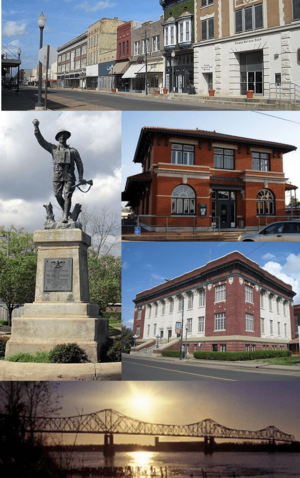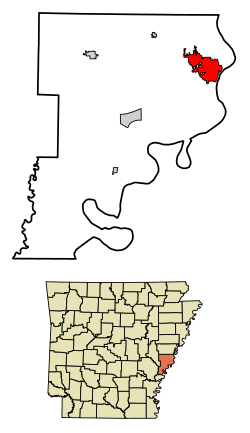Helena–West Helena, Arkansas facts for kids
Quick facts for kids
Helena–West Helena, Arkansas
|
|
|---|---|

Clockwise from top: Cherry Street Historic District, the Delta Cultural Center, Phillips County Courthouse, the Helena Bridge over the Mississippi River and the Spirit of the American Doughboy Monument
|
|

Location of Helena-West Helena in Phillips County, Arkansas.
|
|
| Country | United States |
| State | Arkansas |
| County | Phillips |
| Helena founded | 1833 |
| West Helena founded | 1926 |
| Founded | 2006 |
| Incorporated | 2006 |
| Named for | Helena Phillips |
| Area | |
| • Total | 13.09 sq mi (33.91 km2) |
| • Land | 13.09 sq mi (33.91 km2) |
| • Water | 0.00 sq mi (0.00 km2) |
| Population
(2020)
|
|
| • Total | 9,519 |
| • Density | 726.97/sq mi (280.70/km2) |
| Time zone | UTC-6 (CST) |
| • Summer (DST) | UTC-5 (CDT) |
| ZIP code(s) |
72342, 72390
|
| FIPS code | 05-31190 |
| GNIS feature ID | 2404679 |
Helena–West Helena is a city in Phillips County, Arkansas, United States. It's the largest city and the county seat. The city was formed on January 1, 2006, by combining two older cities: Helena and West Helena.
Helena is located on low land between the Mississippi River and a unique geographical feature called Crowley's Ridge. West Helena is on the western side of Crowley's Ridge. This ridge stands out because the rest of the Arkansas Delta area is mostly flat. The Helena Bridge, one of only four bridges over the Mississippi River in Arkansas, connects the city to Mississippi. In 2020, the city had a population of 9,519 people.
The history of Helena–West Helena began in 1833 when Helena was founded as a port town on the Mississippi River. It became an important center for cotton farms before the American Civil War. During the Civil War, the Union Army took control of Helena. In 1863, the Battle of Helena took place here when Confederate forces tried to take the city back. They wanted to help the city of Vicksburg, Mississippi, but they were not successful. Later that year, Helena was used as a starting point for the Union Army to capture Little Rock, the state capital.
In the 1940s and 1950s, many blues musicians moved to Helena for jobs. The city became a lively center for blues music. However, in the 1970s, a large tire factory closed, which caused many people to lose their jobs.
Today, Helena–West Helena has several interesting places to visit. These include the Delta Cultural Center, the Pillow-Thompson House, and the Helena Confederate Cemetery. The city also hosts the annual King Biscuit Blues Festival every October, which is a very popular event for blues music fans.
Contents
History of Helena–West Helena
The city of Helena was started by European Americans in 1833. It was a useful port on the Mississippi River. Crowley's Ridge offered higher ground and some protection from floods, which was rare along the lower Mississippi River.
The Civil War in Helena
During the American Civil War, the Union Army occupied Helena before the Battle of Helena in 1863. On July 4, 1863, Confederate soldiers tried to capture Helena again. They hoped this would help ease the pressure on Vicksburg, Mississippi, another important river town. However, the Confederate forces in Vicksburg had already agreed to surrender to General Ulysses S. Grant that same morning. Many of the old battle sites are still in Helena today.
Joining Two Cities
Before they joined together, Helena had about 6,323 people, and West Helena had about 8,689 people. People started talking about combining the cities in 2002. In March 2005, citizens of both cities voted to merge. The two cities officially became one on January 1, 2006. People who supported the merger believed that combining the cities would help them get more support and projects to improve the local economy and living standards.
Musical History of Helena–West Helena
In the 1940s and 1950s, Helena became a popular place for African Americans from rural Arkansas and the Mississippi Delta. They came looking for jobs, and some also worked as full-time musicians. Helena was about 70% Black at that time. Many blues pianists like Sunnyland Slim, Memphis Slim, and Roosevelt Sykes played in the local music clubs, called juke joints.
King Biscuit Time Radio Show
In November 1941, a local businessman helped start the town's first radio station, KFFA. A group of blues musicians were given a one-hour radio show if they could find a sponsor. A company called King Biscuit Flour agreed to sponsor them. This led to the famous radio show King Biscuit Time, which featured blues musicians.
King Biscuit Blues Festival
The King Biscuit Blues Festival started in the late 1900s as an annual event in October. It was renamed the Arkansas Blues and Heritage Festival in 2005. This festival is one of the biggest blues festivals in the world. It takes place in downtown Helena on Cherry Street. In 2010, the festival was renamed back to the King Biscuit Blues Festival during a 25th-anniversary performance by the famous musician B.B. King.
Population and People
| Historical population | |||
|---|---|---|---|
| Census | Pop. | %± | |
| 1850 | 614 | — | |
| 1860 | 1,551 | 152.6% | |
| 1870 | 2,249 | 45.0% | |
| 1880 | 3,652 | 62.4% | |
| 1890 | 5,189 | 42.1% | |
| 1900 | 5,552 | 7.0% | |
| 1910 | 8,772 | 58.0% | |
| 1920 | 9,112 | 3.9% | |
| 1930 | 8,316 | −8.7% | |
| 1940 | 8,546 | 2.8% | |
| 1950 | 11,236 | 31.5% | |
| 1960 | 11,500 | 2.3% | |
| 1970 | 10,415 | −9.4% | |
| 1980 | 9,598 | −7.8% | |
| 1990 | 7,491 | −22.0% | |
| 2000 | 6,323 | −15.6% | |
| 2010 | 12,282 | 94.2% | |
| 2020 | 9,519 | −22.5% | |
| U.S. Decennial Census Data is for the city of Helena alone prior to 2010 |
|||
As of the 2020 Census, there were 9,519 people living in Helena–West Helena. The city had 4,191 households and 2,515 families.
Economy and Jobs
The main economic activity in Helena–West Helena is still agriculture, especially growing cotton. However, new machines and large farms mean that fewer people are needed for farm work now than in the past.
Another important part of the economy is the port on the Mississippi River. Barges carry goods, creating jobs and income for the city. Retail stores and tourism also provide jobs and money for the community.
In 2006, there were plans for a company called E-Fuels to build an ethanol fuel refinery in the area. This project was expected to bring new jobs and more traffic to the city's port. The city also planned to reopen its regional landfill, which could earn fees for Helena–West Helena.
Cultural Institutions
- Delta Cultural Center
- Helena Museum of Phillips County
- Phillips County Library
- Lily Peter Auditorium (Phillips Community College of the University of Arkansas)
Media
The Helena-West Helena World is the local newspaper for the city.
Education
Higher Education
- Phillips Community College of the University of Arkansas
Public Schools
The Helena–West Helena School District runs the public schools.
- Central High School (Grades 7–12), located in West Helena.
- J.F. Wahl Elementary School (Grades K–6), located in Helena.
KIPP: Delta Public Schools operates a group of charter schools in the city.
- KIPP: Elementary Literacy Academy (grades K–4)
- KIPP: Delta College Preparatory School (grades 5–8)
- KIPP: Delta Collegiate High School (grades 9–12)
Private Schools
- DeSoto School (Kindergarten through 12th grade).
Former Schools
- St. Catherine's Academy (grades 1-12) - This was a Catholic school that opened in 1857. It closed in 1868. Later, a new school called Sacred Heart Academy opened in 1879. It taught Catholic children for free and some non-Catholic children whose parents paid tuition. Sacred Heart closed in the late 1960s. The building was later torn down.
- Eliza Miller School (grades 1-12) - This school was partly funded by local businesswoman Eliza Ann Ross Miller. It closed in the 1970s after schools in Helena became desegregated. Famous musicians like the Staple Singers and B. B. King performed at this school.
Notable People
- John Hanks Alexander - the second African-American graduate from West Point
- Fred Childress - all-star football player in the Canadian Football League
- Patrick Cleburne - a general in the Confederate army during the American Civil War
- Ken Hatfield - a college football coach for teams like Clemson and Arkansas
- Levon Helm - musician, member of The Band
- Alex Johnson - Major League Baseball player
- Mary Lambert - music video director
- Blanche Lincoln - U.S. senator from Arkansas
- Robert Lockwood, Jr. - blues musician
- Robert Lee McCollum - blues musician
- Elias Camp Morris - minister, politician, and businessman
- John Stroger, Jr. - longtime president of the Board of Commissioners of Cook County, Illinois
- Roosevelt Sykes - blues pianist
- Conway Twitty (born Harold Lloyd Jenkins) - country music star who grew up in Helena
- Ellis Valentine - former Major League Baseball player
- Sonny Boy Williamson II - blues musician
- Richard Wright - author of fiction and autobiography
Images for kids
-
The view from the Battery C park over downtown Helena. Battery C was a station in the Battle of Helena.
-
The historical Confederate graveyard placard from the Battle of Helena
See also
 In Spanish: Helena-West Helena para niños
In Spanish: Helena-West Helena para niños









